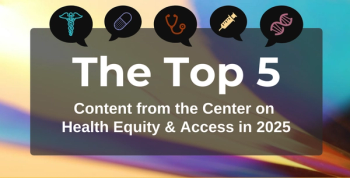
Contributor: Rebuilding Trust in Health Care Quality and Value—Leadership Priorities for Managed Care
Measures need to be taken to elevate engagement both from employees and the general public as public confidence in the US health care system declines.
The US health care system faces declining levels of public confidence. Gallup polling documents that only 44% of Americans currently rate national health care quality as “excellent” or “good,” the lowest level in more than 2 decades.1 The West Health–Gallup indices similarly find that fewer than half of adults feel that their most recent health care encounter was “worth the cost.”2
This decline reflects not only concerns about access and affordability but also a broader reputational problem. In Gallup’s 2025 industry ratings, health care has only a middling level of trust for 25 industries rated.3 This finding underscores that health care leaders are not only managing quality and cost concerns but also confronting a sector-wide trust deficit.
The challenge is compounded internally. Gallup’s Q1 2025 workplace engagement report shows that only about 31% of US employees are engaged, the lowest in a decade.4 The steepest declines are in clarity of expectations, feeling cared for, and connection to mission or purpose.4 For health care organizations, where clinician and staff engagement directly influence patient outcomes, this internal erosion poses risks equal to external distrust.
Managed care organizations (MCOs), situated at the intersection of payers, providers, and patients, are uniquely placed to address these dual gaps. This article outlines 10 leadership priorities—5 foundational imperatives and 5 expanded strategies—that together form an agenda for rebuilding trust in health care quality and value.
Core Leadership Imperatives
Both managed care organizations and health care delivery systems shape quality and value—MCOs through the design of payment, measurement, and incentive frameworks, and providers through the lived execution of care and culture.
1. Equity as a quality dimension
Disparities in affordability and access are strongly correlated with diminished perceptions of value; Hispanic and Black adults remain disproportionately likely to report being “cost desperate.”2 MCOs can embed equity into their quality frameworks by stratifying performance by demographic variables and linking equity improvements to incentive payments. CMS has signaled this direction in its equity emphasis for value-based contracting.5
2. Redefining value from the patient perspective
Patients increasingly assess care in terms of whether it feels worth the cost—judgments not captured by clinical metrics alone. Patient-reported outcome measures (PROMs) and patient-reported experience measures should be integrated into quality reporting.6 A recent review from The American Journal of Managed Care found that US insurers are using PROMs in population health management and contracting decisions, underscoring their applicability for managed care.7
3. Cost transparency as a quality imperative
Financial uncertainty undermines perceptions of quality. Embedding financial navigators into care planning and offering clear, timely explanations of coverage, out-of-pocket obligations, and trade-offs can transform cost conversations into trust-building moments. Research suggests that patients who understand expected costs report higher satisfaction and adherence.8
4. Workforce engagement as a quality lever
Staff turnover, burnout, and disengagement compromise continuity, empathy, and reliability. Gallup’s Q1 2025 data show that only 33% of US health care workers are engaged, and the steepest declines are in clarity of expectations, feeling cared for, and mission connection.4 These 3 elements are not abstract: in health care settings, they shape whether clinicians remain focused, patients feel respected, and teams deliver consistent care.
MCOs should embed these engagement drivers into their leadership agenda by:
- Expectation clarity: co-creating goals and aligning role expectations with quality measures.
- Feeling cared for: strengthening relational support through manager listening sessions and peer networks.
- Mission connection: reinforcing purpose through alignment dialogues, patient storytelling, and visible leadership commitment.
When these elements are integrated into performance contracts and organizational incentives, engagement becomes a measurable determinant of quality and value.
5. Measuring quality where patients experience it
Traditional metrics (mortality, readmissions) often miss the encounters that shape trust—access, coordination, and communication. Real-time feedback tools (short post-encounter surveys, text prompts) make quality actionable and responsive.9 When patients see rapid correction of identified issues, confidence in quality improves.
Expanding the Leadership Agenda
Beyond foundational imperatives, MCOs may consider complementary strategies that extend quality and value frameworks into areas more directly tied to patient trust and clinician engagement.
6. Physicians as value translators
Patients rarely connect clinical decisions to value. Training and incentivizing physicians to explain alternatives, outcomes, and financial implications positions them as interpreters of value. This reinforces trust and aligns clinical decisions with patient expectations.
7. Linking quality goals to professional autonomy
Quality programs often feel like compliance burdens. Reframing them as enablers—through reduced administrative load, streamlined prior authorization, or clearer decision pathways—encourages physicians to see quality initiatives as supportive of their professional practice.
8. Establishing quality rounds with staff
Structured discussions with frontline staff about handoffs, delays, and communication gaps involve them as contributors to quality improvement rather than passive executors. This approach uncovers issues early and strengthens ownership of solutions.
9. Incorporating value narratives into improvement
Dashboards cannot fully capture human experiences of care. Soliciting and integrating patient and staff stories into quality reviews adds texture to performance data and highlights where trust is won or lost.
10. Recognition anchored in patient feedback
Recognition programs should extend beyond productivity measures. Highlighting staff or physicians cited in patient feedback for respect, clarity, or compassion aligns organizational rewards with what patients most closely associate with value.
Implications for Managed Care
For MCOs, implementing these priorities requires action on 2 fronts:
- Externally: Aligning payment models, quality frameworks, and contracting strategies with patient-defined value, equity, and affordability.
- Internally: Addressing engagement deficits in clarity, caring relationships, and mission connection to stabilize the workforce and sustain quality initiatives.
By confronting both external distrust and internal disengagement, MCOs can restore legitimacy and strengthen the credibility of value-based care.
Quality and value cannot be managed as separate goals. With public ratings of health care among the lowest of all industries, and staff engagement in decline, leaders face parallel crises of trust inside and outside their organizations. Foundational imperatives—equity, patient-centered metrics, workforce culture—are essential. Yet additional strategies that emphasize physician communication, staff participation, and narrative feedback are increasingly necessary to close the trust gap.
For managed care, the measure of value is not only in outcomes and costs but also in whether patients and staff believe the system is worth their trust and effort. That perception should serve as a central indicator of whether managed care is fulfilling its purpose.
References
- Brenan M. View of healthcare quality in U.S. declines to 24-year low. Gallup. December 6, 2024. Accessed October 14, 2025.
https://news.gallup.com/poll/654044/view-healthcare-quality-declines-year-low.aspx - Gallup, West Health. 2025 report: tracking healthcare affordability and value. Gallup. January 2025. Accessed October 14, 2025.
https://a-us.storyblok.com/f/1022212/x/30b890d53d/2025-west-health-gallup-report.pdf - Brenan M. Farming, computer, restaurant industries lead U.S. ratings. Gallup. September 25, 2025. Accessed October 14, 2025.
https://news.gallup.com/poll/695555/farming-computer-restaurant-industries-lead-ratings.aspx - Harter J. U.S. employee engagement sinks to 10-year low. Gallup. January 13, 2025. Accessed October 14, 2025.
https://www.gallup.com/workplace/654911/employee-engagement-sinks-year-low.aspx - CMS. CMS framework for health equity 2022–2032. CMS. 2022. Accessed October 14, 2025.
https://www.cms.gov/files/document/cms-framework-health-equity.pdf - Black N. Patient reported outcome measures could help transform healthcare. BMJ. 2013;346:f167. doi:10.1136/bmj.f167
- Hanmer J, Cizik AM, Gulek BG, et al. A scoping review of US insurers’ use of PROMs. Am J Manag Care. 2022;28(6):e232–e238. doi:10.37765/ajmc.2022.89162
- Ubel PA, Abernethy AP, Zafar SY. Full disclosure—out-of-pocket costs as side effects. N Engl J Med. 2013;369(16):1484-1486. doi:10.1056/NEJMp1306826
- Shanafelt TD, Noseworthy JH. Executive leadership and physician well-being: nine organizational strategies to promote engagement and reduce burnout. Mayo Clin Proc. 2017;92(1):129-146. doi:10.1016/j.mayocp.2016.10.004
- Manary MP, Boulding W, Staelin R, Glickman SW. The patient experience and health outcomes. N Engl J Med. 2013;368(3):201-203. doi:10.1056/NEJMp1211775
Newsletter
Stay ahead of policy, cost, and value—subscribe to AJMC for expert insights at the intersection of clinical care and health economics.








































